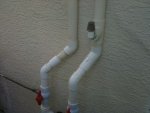- Oct 23, 2008
- 90
- Pool Size
- 20000
- Surface
- Plaster
- Chlorine
- Salt Water Generator
- SWG Type
- Hayward Aqua Rite (T-15)
The breaker/relief valve is not at the highest point of the piping on the roof but rather on the supply side piping near the equipment pad. The installer told me "that's the way we do it around here, if the valve leaks/fails, it's easier to replace the valve at ground level instead of climbing on the roof". Should the valve be relocated to the roof?
Thanx.
Thanx.


